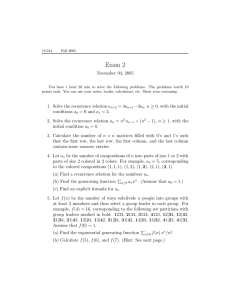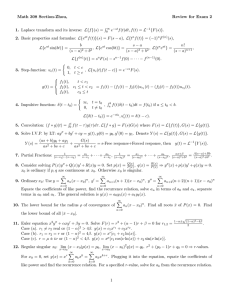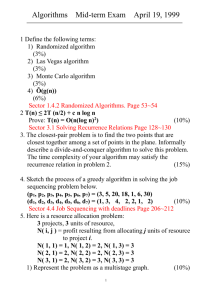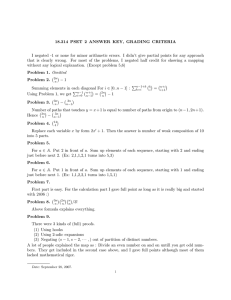Recurrence of Tandem Queues under Random Perturbations Florian Sobieczky 13. M¨arz 2011
advertisement
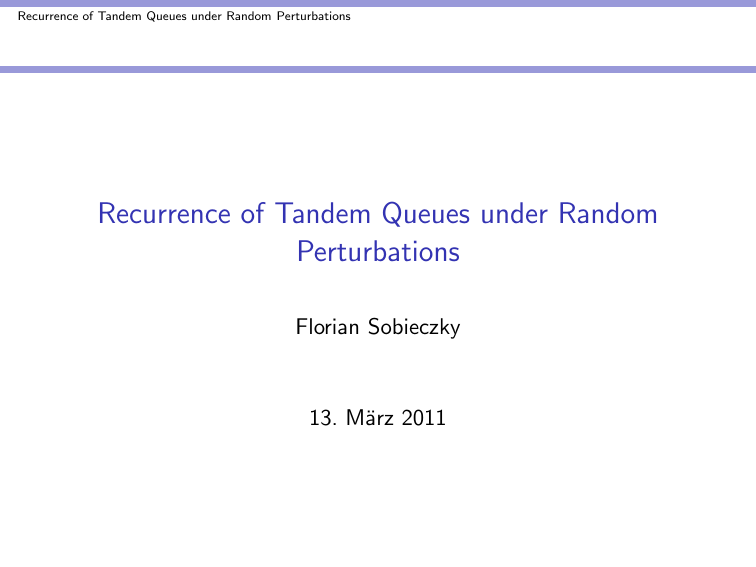
Recurrence of Tandem Queues under Random Perturbations Recurrence of Tandem Queues under Random Perturbations Florian Sobieczky 13. März 2011 Recurrence of Tandem Queues under Random Perturbations Contents Queues Queues in Series Quarter-plane Random Walk Perturbations of the Tandem-Queue Recurrence of perturbed Tandem Queues Recurrence of perturbed Tandem Queues Literature Recurrence of Tandem Queues under Random Perturbations Queues M/M/1-Queues Recurrence of Tandem Queues under Random Perturbations Queues M/M/1-Queues Recurrence of Tandem Queues under Random Perturbations Queues M/M/1-Queues Tj Period between delivery, Sj period between customer’s interest Recurrence of Tandem Queues under Random Perturbations Queues M/M/1-Queues Tj Period between delivery, Sj period between customer’s interest Recurrence of Tandem Queues under Random Perturbations Queues in Series Tandem-Queues Recurrence of Tandem Queues under Random Perturbations Queues in Series Tandem-Queues Buying-rate λ Inventory-Size Nt Inquiry-Rate µ Recurrence of Tandem Queues under Random Perturbations Queues in Series Tandem-Queues Buying-rate λ Inventory-Size Nt Inquiry-Rate µ · Criterion for positive Recurrence: λ < µ · In Equilibrium πk := P[Nt = k] = (1 − ρ)ρk , where ρ = · Expected asymptotic size of inventory: (by ergodicity) ρ λ lim E[Nt ] = Eπ [Nt ] = 1−ρ = µ−λ t→∞ λ µ Recurrence of Tandem Queues under Random Perturbations Queues in Series Tandem-Queues Buying-rate λ Inventory-Size Nt Inquiry-Rate µ · Criterion for positive Recurrence: λ < µ · In Equilibrium πk := P[Nt = k] = (1 − ρ)ρk , where ρ = · Expected asymptotic size of inventory: (by ergodicity) ρ λ lim E[Nt ] = Eπ [Nt ] = 1−ρ = µ−λ t→∞ λ µ Recurrence of Tandem Queues under Random Perturbations Quarter-plane Random Walk Quarter-plane Random Walk Recurrence of Tandem Queues under Random Perturbations Quarter-plane Random Walk Quarter-plane Random Walk Recurrence of Tandem Queues under Random Perturbations Quarter-plane Random Walk Quarter-plane Random Walk Recurrence of Tandem Queues under Random Perturbations Quarter-plane Random Walk Burke’s Theorem I Recurrence of Tandem Queues under Random Perturbations Quarter-plane Random Walk Burke’s Theorem II Recurrence of Tandem Queues under Random Perturbations Perturbations of the Tandem-Queue Random Weights Recurrence of Tandem Queues under Random Perturbations Perturbations of the Tandem-Queue Random Weights Rates µk state-dependent: criterion positive recurrence n ∞ Y X λn / µk < ∞ λ and n=0 k=1 Recurrence of Tandem Queues under Random Perturbations Perturbations of the Tandem-Queue Random Weights Rates µk state-dependent: criterion positive recurrence n ∞ Y X λn / µk < ∞ λ and n=0 k=1 Rates µk (ω) state-dependent, random: criterion almost sure positive recurrence n ∞ Y X n λ E[ µ−1 λ and k ] < ∞ n=0 k=1 Recurrence of Tandem Queues under Random Perturbations Perturbations of the Tandem-Queue Random Weights Rates µk state-dependent: criterion positive recurrence n ∞ Y X λn / µk < ∞ λ and n=0 k=1 Rates µk (ω) state-dependent, random: criterion almost sure positive recurrence n ∞ Y X n λ E[ µ−1 λ and k ] < ∞ n=0 k=1 Recurrence of Tandem Queues under Random Perturbations Perturbations of the Tandem-Queue Example: Random vertikal conductances µk ∼Binom, i.i.d: P[µk = λ + ] = p = 1 − P[µk = λ − ] α κ λ µκ The Process is positive recurrent iff p > 1 2 1+ λ . Recurrence of Tandem Queues under Random Perturbations Recurrence of perturbed Tandem Queues Other ‘Perturbed’ Tandem-Queues A continuous-time random walk (such as a queueing-system) consists of three steps: Let j = 0 1. Wait exp.-distrib. Time with rate λ + µ µ λ 2. Jump to neighbours with Probabilities λ+µ , λ+µ 3. Increase j by one and goto 1. Recurrence of Tandem Queues under Random Perturbations Recurrence of perturbed Tandem Queues Other ‘Perturbed’ Tandem-Queues A continuous-time random walk (such as a queueing-system) consists of three steps: Let j = 0 1. Wait exp.-distrib. Time with rate λ + µ µ λ 2. Jump to neighbours with Probabilities λ+µ , λ+µ 3. Increase j by one and goto 1. Idea: Replace step 2. with different Jump-Rules Recurrence of Tandem Queues under Random Perturbations Recurrence of perturbed Tandem Queues Other ‘Perturbed’ Tandem-Queues A continuous-time random walk (such as a queueing-system) consists of three steps: Let j = 0 1. Wait exp.-distrib. Time with rate λ + µ µ λ 2. Jump to neighbours with Probabilities λ+µ , λ+µ 3. Increase j by one and goto 1. Idea: Replace step 2. with different Jump-Rules Recurrence of Tandem Queues under Random Perturbations Recurrence of perturbed Tandem Queues Simulating time-inhomogeneous RW’s Rates µk state-dependent: criterion positive recurrence No perturbation of α, λ implies: Burke’s theorem still applicable. Recurrence of Tandem Queues under Random Perturbations Recurrence of perturbed Tandem Queues Simulating time-inhomogeneous RW’s Rates µk state-dependent: criterion positive recurrence No perturbation of α, λ implies: Burke’s theorem still applicable. Recurrence of Tandem Queues under Random Perturbations Recurrence of perturbed Tandem Queues Simulating time-inhomogeneous RW’s: Results Two different modifications of step 2.: Perturbed chain is projection of chain on covering graph onto ‘original’ graph (integer-line); Projections must be Markov-Processes! 2’. First pick layer (where to end up) with probability 1/2, then use probabilities depending on layer where currently situated: λ2 + λα ≤ µµ0 + α(µ + µ0 )/2 implies positive recurrence. Recurrence of Tandem Queues under Random Perturbations Recurrence of perturbed Tandem Queues Simulating time-inhomogeneous RW’s: Results Two different modifications of step 2.: Perturbed chain is projection of chain on covering graph onto ‘original’ graph (integer-line); Projections must be Markov-Processes! 2’. First pick layer (where to end up) with probability 1/2, then use probabilities depending on layer where currently situated: λ2 + λα ≤ µµ0 + α(µ + µ0 )/2 implies positive recurrence. 2”. Pick any of the directions in the graph with probability proportional to its designated rate: λ ≤ (µ + µ0 )/2 implies positive recurrence. Recurrence of Tandem Queues under Random Perturbations Recurrence of perturbed Tandem Queues Simulating time-inhomogeneous RW’s: Results Two different modifications of step 2.: Perturbed chain is projection of chain on covering graph onto ‘original’ graph (integer-line); Projections must be Markov-Processes! 2’. First pick layer (where to end up) with probability 1/2, then use probabilities depending on layer where currently situated: λ2 + λα ≤ µµ0 + α(µ + µ0 )/2 implies positive recurrence. 2”. Pick any of the directions in the graph with probability proportional to its designated rate: λ ≤ (µ + µ0 )/2 implies positive recurrence. Recurrence of Tandem Queues under Random Perturbations Recurrence of perturbed Tandem Queues Simulation Results and Open Questions Recurrence of Tandem Queues under Random Perturbations Recurrence of perturbed Tandem Queues Simulation Results and Open Questions Recurrence of Tandem Queues under Random Perturbations Literature Literatur I P. J. Burke: The Output of a Queueing System, 1956 I G Fayolle, V. A. Malyshev, M. V. Men’shikov: Topics in the Constructive Theory of Countable Markov Chains, 1995 I F. Sobieczky, G. Rappitsch, E. Stadlober: Tandem Queues for Inventory Management under Random Perturbations, 2010 Recurrence of Tandem Queues under Random Perturbations Literature α κ λ µκ Abbildung: Thank you for your interest!


